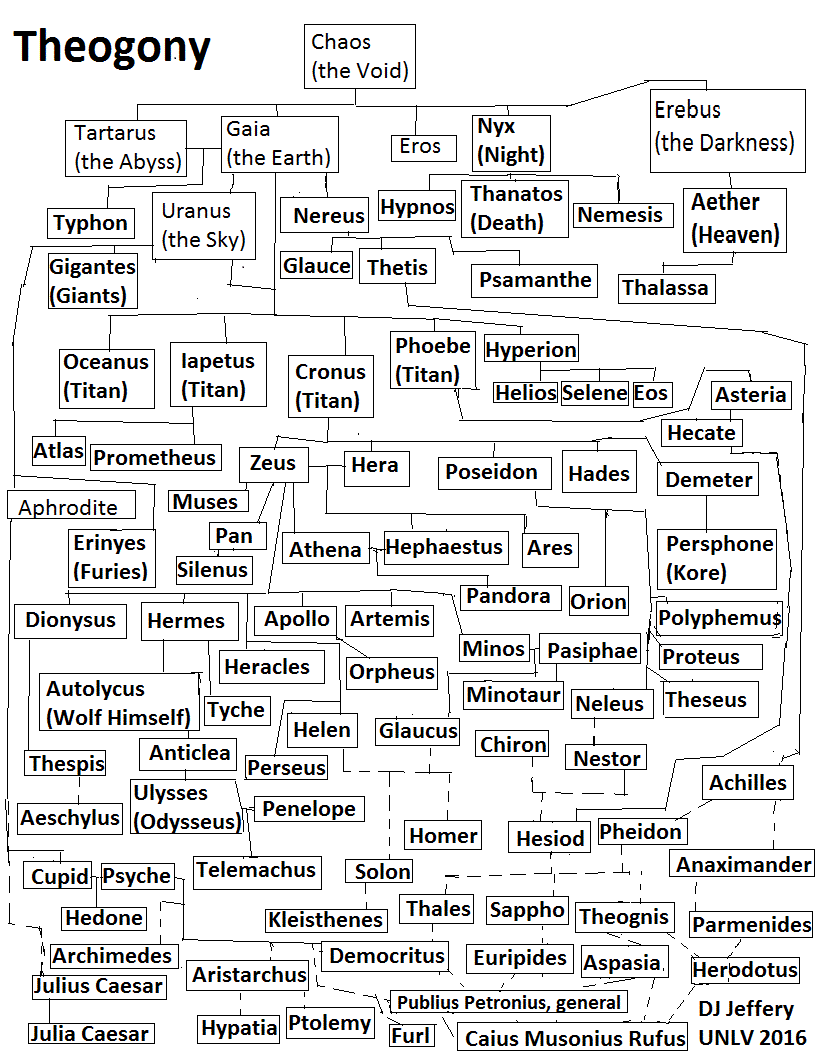
Caption: Theogony (circa late 8th century BCE): The geneology of the Greek gods---with a few nifty additions by yours truly.
Features:
- The origin
of the Greek gods
is their theogony.
The most eldest---and therefore most authoritative---record is the epic poem Theogony by Hesiod (circa late 8th century BCE)---whose name can be affectedly, but poetically, pronounced He-side.
Other classical writers supplement and often contradict Theogony---Greek mythology was an evolving collage originating from various sources with NO strict canon.
See Wikipedia: Family tree of the Greek gods for some of what Hesiod and others winged up.
- For the Theogony in the figure, yours truly
has just collected the
Greek mythological persons
who are most mythic and given their most
mythic geneologies.
Poetic license commanded that yours truly engraft historical persons who are mythic---with mythic geneologies.
Vertical and oblique solid lines indicate parent and child; horizontal solid lines indicate parents.
Dashed lines indicate descent, but NOT parent and child.
The time increases roughly going down, but compaction required some out-of-sequence orderings. Also many of the mythological persons have no fixed origin date, just the mythic past.
There are some anomalies in the entries to be described below.
- Mythic Chaos
or cosmogonic Chaos is the
ancestor of all.
His/Her/It's name does NOT mean "chaos" in the modern sense, but gap, gulf, chasm, or void. The later makes most sense for a creatio ex nihilo.
- Zeus is a special case.
Theogony
puts him in the 4th generation counting from
mythic Chaos
(see Wikipedia: Family tree of the Greek gods).
But Zeus
evolved from
Dyeus
or Dyeus Phter
(Sky Father),
the Proto-Indo-European
sky diety.
The Proto-Indo-Europeans flourished in the 4th millennium BCE, and so Zeus may be the oldest Greek god in the historical record.
- There are 3 cases where connecting lines were NOT drawn to avoid ugly crossings.
Chiron was the
son of
Cronus.
Pasiphae was the
daughter
of Helios.
Penelope
a great granddaughter of
Poseidon.
- Glauce,
Glaucus,
and Thalassa were
included because they have pretty
names---Thalassa! Thalassa!.
- Polyphemus is the
cyclops from
Odyssey.
The Minotaur had the
proper name
Asterion.
- Psamanthe
is included for
a personal myth.
- Pandora was created by
Athena and
Hephaestus---but there is but one way.
- Julius Caesar (100--44 BCE)---old
Caius himself---claimed
descent from mythic Venus
(Aphrodite):
see Wikipedia: Julius Caesar: Early life and career.
- Aside from
Julius Caesar
and his daughter,
Julia Caesar,
all the connections to and among
historical persons
"are all my own invention" as said
the White Knight.
- I insighted that Hecate in
the Boeotian
town
Ascra
mated with a grumpy farmer---they all look the same
in the dark---and generated
Hesiod---who was a good
son to his old
mother.
- Fascinatingly, I have
Psyche mate with
Democritus (c.460--c.370 BCE).
Psyche is the only person without a mythic geneology.
- Furl
is the last Presocratic philosopher.
- I insighted that Hecate in
the Boeotian
town
Ascra
mated with a grumpy farmer---they all look the same
in the dark---and generated
Hesiod---who was a good
son to his old
mother.
- The mythological persons
and mythic historical persons
in alphabetical order:
-
Achilles,
Aeschylus (c.525--c.455),
Aether (Heaven),
Anaximander (c.610--c.546 BCE),
Anticlea,
Aphrodite
(AKA Venus (mythic)),
Apollo,
Archimedes (c.287--c.212 BCE),
Aristarchos of Samos (c.310--c.230 BCE),
Ares,
Artemis,
Aspasia (c.470--c.400 BCE),
Asteria,
Athena,
Atlas,
Autolycus (Wolf Himself, Very Wolf),
Caius Musonious Rufus (c.25--c.100 CE)
(Bertrand Russell (1872--1970)
recognized him as a soulmate),
Chaos (mythic),
Chiron
Cronus,
Cupid,
Demeter,
Democritus (c.460--c.370 BCE),
Dionysus,
Eos,
Erebus (the Darkness),
Erinyes (Furies),
Eros,
Euripides c.480--c.406 BCE),
Furl,
Gaia (the Earth),
Gigantes (Giants),
Glauce,
Glaucus,
Hades,
Hecate,
Hedone,
Helen of Troy,
Helios,
Hephaestus,
Hera,
Heracles (Hercules),
Hermes,
Herodotus (c.484--c.425 BCE),
Hesiod (circa late 8th century BCE),
Homer (circa 700 BCE),
Hypatia (c.360--415 CE),
Hyperion,
Hypnos,
Iapetus,
Julia Caesar (c.76--54),
Julius Caesar (100--44 BCE),
Kleisthenes (fl. 510 BCE),
Minos
Minotaur
(AKA Asterion),
Muses,
Neleus,
Nemesis,
Nereus,
Nestor,
Nyx (Night),
Oceanus,
Orion (mythic),
Orpheus,
Pan,
Pandora,
Parmenides of Elea (early 5th century BCE),
Pasiphae,
Penelope,
Persephone (Kore),
Perseus,
Pheidon (8th or 7th century BCE),
Phoebe,
Polyphemus
(a cyclops),
Poseidon,
Prometheus,
Proteus,
Psamanthe,
Psyche,
Ptolemy (c.100--c.170 CE),
Publius Petronius, general (fl. 40 CE),
Sappho (c.620--c.570 BCE),
Selene,
Solon (c.638--c.558 BCE),
Silenus,
Tartarus (the Abyss),
Thalassa,
Thanatos (Death),
Thales (c.624--c.546 BCE),
Thespis (fl. 530 BCE),
Thetis,
Theognis (6th century BCE),
Titans,
Tyche,
Typhon,
Ulysses (AKA Odysseus),
Uranus (the Sky),
Zeus.
Credit/Permission: ©
David Jeffery,
2016 / Own work.
Image link: Itself.
Local file: local link: theogony.html.
File: Ancient Astronomy file:
theogony.html.